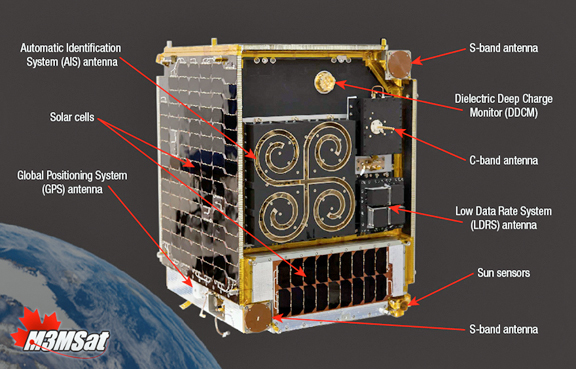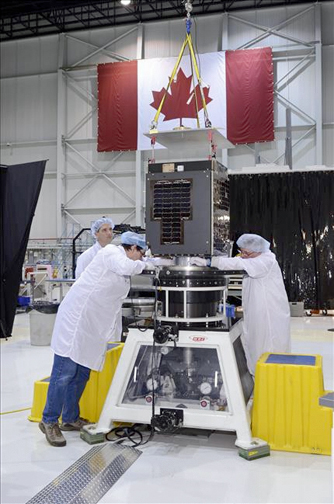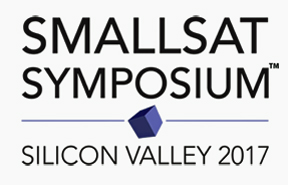
On June 21, Canada's Maritime Monitoring and Messaging Microsatellite (M3MSat) will launch aboard a Polar Satellite Launch Vehicle (PSLV) from Satish Dhawan Space Centre in Sriharikota, India. Also on board will be the first demo satellite of the Canadian company, GHGSat.
The M3MSat mission aims to test and demonstrate the viability of new technologies that will advance Canada's capabilities in monitoring maritime traffic. M3MSat was developed jointly by the Canadian Space Agency (CSA) and Defence Research and Development Canada (DRDC) to meet complementary objectives.

The Canadian Maritime Monitoring and Messaging Microsatellite (M3MSat) is the latest of small-but-mighty spacecraft sent to test innovative technologies in space before they're deployed on full-scale missions. The mission aims to improve Canada's space-based capabilities to detect ships and manage marine traffic and will also test a device that could change the way we monitor the health and safety of satellites.
M3MSat demonstrates the kinds of unique solutions that space and new technologies can provide and is also a great example of collaboration between government, industry and academia to drive innovation in Canada's space sector.
Enhancing Canada's Maritime Traffic Monitoring
Automatic Identification System (AIS) technology transmits important information on ships' identity, heading and speed. Ships use AIS signals to detect other ships and avoid collisions at sea, and coastal authorities use them to enhance marine safety and monitor maritime traffic. The placement of AIS technology on satellites in recent years has revolutionized how we monitor and manage marine safety by providing a more complete view of maritime traffic. One of the main objectives of M3MSat is to build on and improve Canada's space-based AIS capabilities. Part of M3MSat's mission is to test an AIS antenna with advanced capabilities that promises higher performance for identification and conflict resolution of the signals. The compact antenna was designed by the University of Waterloo and is the first and only one of its kind.
While in space, M3MSat will also test a device, the Low Data Rate Service (LDRS), to ensure surveillance and data continuity when AIS receivers cannot provide real-time coverage. The LDRS will receive transmissions collected by stations in remote areas such as the Arctic. Then it will pass the information on to Canadian marine traffic control centers.
Improving Satellite Health Monitoring
The accumulation of static energy in a satellite is detrimental to its electronics. While it is possible to reduce the charge by raising the temperature of the spacecraft temporarily, the CSA currently has no way to determine when that needs to be done. M3MSat will test the Dielectric Deep Charge Monitor (DDCM), a device designed to measure the static energy that has accumulated in the satellites' electronics. If successful, the DDCM could improve the way we build and monitor the health and safety of satellites, and help extend the life of satellites in orbit.

The smallsat's box-shaped frame weighs about as much as the average Canadian male (85 kilograms) and is about the size of most household dishwashers. It uses a new type of generic satellite platform design (developed by the University of Toronto Space Flight Lab) that could be used for future missions. This graphic illustrates the main components of the spacecraft.
In preparation for the intense experience of a rocket launch and the extreme temperatures associated with space flight, M3MSat has undergone a series of critical tests. Many of these were completed at the Canadian Space Agency's (CSA's) David Florida Laboratory (DFL), Canada's world-class spacecraft assembly, integration and testing centre located in Ottawa.
M3MSat will be launched by the Indian Space Research Organisation (ISRO) from Sriharikota, India, and will lift off aboard a Polar Satellite Launch Vehicle (PSLV) along with Canadian company GHGSat's first demonstration satellite. GHGSat will test a new way to measure greenhouse gas emissions from industrial facilities. The company has benefited from CSA funding, both through the Space Technology Development Program and the Earth Observation Applications Development Program.

COM DEV technologists Dave Smith and Roman Gawlik check the satellite mounting fixture before Canadian Space Agency (CSA) employees perform mass properties testing in the CSA’s David Florida Laboratory (DFL).
Photo is courtesy of COM DEV.
After the launch, M3MSat will circle the Earth from pole to pole at an altitude of 505 km and will travel over Canadian waters approximately ten times a day. Once commissioned, the satellite will be owned by the Defence Research and Development Canada (DRDC) and operated by the Satellite Operations Centre at the CSA. Operators will use AIS aboard M3MSat independently or in conjunction with RADARSAT-2 by comparing Synthetic Aperture Radar (SAR) images with information captured by M3MSat.
M3MSat is a joint mission of the CSA and DRDC. The CSA is responsible for the LDRS and DDCM instruments, and DRDC is responsible for the AIS. The satellite was built by Ontario-based company COM DEV International (now Honeywell Canada), with support from the University of Toronto Institute for Aerospace Studies and the University of Waterloo.
Dawdle Not... SmallSat Symposium Dates Set For 2017

Within the smallsat community, those who hesitate in preparing and planning their next business moves within such a dynamic environment could well be "left behind."
To assist in acquiring the knowledge and expertise to enter and/or continue the acquisition of technology and product to become a successful smallsat actor, Satnews Publishers is delighted to announce that the SmallSat Symposium workshops will be held on February 6 and the conference will be conducted from February 7 to February 8, 2017, at the Computer History Museum, which is located at 1401 North Shoreline Boulevard in Mountain View, California.
A veritable "Who's Who" of subject-matter experts have already committed to presentations during this impact-filled symposium... the accepted speakers to date include...
- Chad Anderson, Managing Director Space Angels Network
- Jason Andrews, CEO Spaceflight Industries David A. Anhalt, Vice President and General Manager Iridium PRIME
- Chris Baugh, President NSR - Northern Sky Research
- Peter Beck, CEO & CTO Rocket Lab
- Dr. Sami BenAmor, Director of Marketing Thales Alenia Space
- John Booher, Partner Hogan Lovells
- Dr. Sean Casey, Managing Director Silicon Valley Space Center
- Carissa Christensen, Managing Partner The Tauri Group
- Craig Clark, Founder Clyde Space Ltd.
- Mike Collett, Founder and Managing Partner Promus Ventures
- James Crawford, Founder and CEO Orbital Insight
- Randy Culver, CEO AMERGINT Technologies
- Stuart Daughtridge, Senior VP Advanced Technology Kratos
- Dr. Lars Dyrud, CEO OmniEarth
- Dr. Shahin Farshchi, Partner Lux Capital
- Dr. Jenny Gautier, Director of Commercial Programs The Aerospace Corporation
- Dr. Steve Goldberg, CEO & Co-Founder Venrock
- David Hartshorn, Secretary General GVF - Global VSAT Forum
- Susan J. Irwin, President Irwin Communications, Inc.
- John P. Janka, Partner Latham & Watkins LLP
- Adam Keith, Managing Director Euroconsult Canada
- Debra Facktor Lepore, VP and GM of Strategic Operations Ball Aerospace & Technologies Corp
- Tony Lin, Counsel, Washington, DC Hogan Lovells
- Dr. Clare Martin, Vice President of Programs Surrey Satellite Technology US
- Clayton Mowry, President Arianespace
- Carlos Niederstrasser, Business Development & Special Initiatives Orbital ATK
- Sunil Nagaraj, Vice President of Marketing and Communications Bessemer Venture Partners
- Dara A. Panahy, Partner Milbank, Tweed, Hadley & McCloy
- Will Pomerantz, Vice President for Special Projects Virgin Galactic
- Dr. Alex Saltman, Senior Vice President GeoOptics Inc.
- Randy S. Segal, Partner, Co-Lead Satellite Practice Hogan Lovells
- David Strobel, CEO and Program Manager (PM) Space Micro
- Chris Stott, Chairman & CEO (PM) ManSat
- Tom Stroup, President SIA - Satellite Industry Association
- Professor Sir Martin Sweeting, Founder and Executive Chairman Surrey Satellite Technology Ltd.
- Stig-Are Thrana, U.S. Sales Director and Head of Kongsberg Silicon Valley Office Kongsberg Satellite Services
- Dr. Joe Thurgood, Vice President Corporate Development and Marketing Hera Systems
- Dr. Marco Villa, President & COO Tyvak Nano-Satellite Systems
- Tony Wilkey, Senior Vice President AvL Technologies
- Bruce Yost, Project Manager NASA Ames Research Center
- Louis Zacharilla, Director of Development Society of Satellite Professionals International (SSPI)
Here's some particularly good news for interested parties — the first 100 registrants will qualify for a $200 discount on the standard event admission... take advantage of this offer... don't dawdle... and register now at this direct link.

